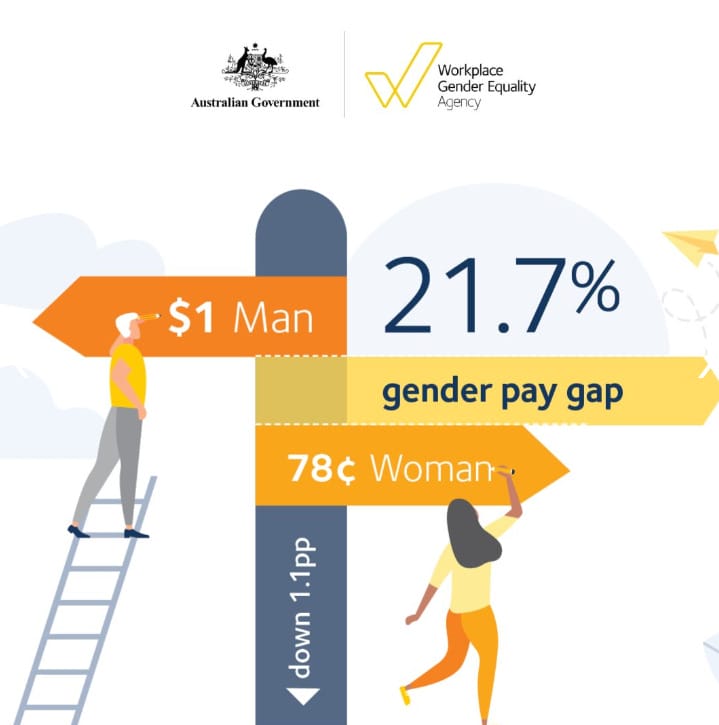Not sure how to improve gender equity in your workplace? Read our top tips for making change.
In this summary of our recent webinar, we explore gender equity stats and the practical ways our panel has taken to improve gender equality in their organisations.
Panel Members:
- Dr Terrence Fitzsimmons, Managing Director, Australian Gender Equality Council (AGEC)
- Adam McSwain, Director of Infrastructure & Assets, Hume City Council
- David Gill, Commercial & Asset Finance Brokers Association of Australia
- Panel moderator – Karen Taylor – CEO Women & Leadership Australia
1. Get informed about gender equity facts
We explored the 2023 World Economic Forum Gender Gap Report in our blog Australian Women’s Struggle for Economic & Financial Security
Also consider reading AGEC’s and WGEA’s extensive research on gender inequality and the gender pay gap in Australia.
Here’s what our panel had to say.
Panel comments – Terry Fitzsimmons:
“94% of CEOS are men, they are the ones that have got their hands on the levers. They’re the ones that run the senior leadership team. They’re the ones that are best placed to champion gender equality initiatives. They are pivotal in eliminating pay gaps, and making people accountable.
Now there’s only 12 female CEOs in the ASX 200. If you measure that progress going back to 2000 and you project that forward, it’ll be the year 2212 before we get to gender parity in ASX 200 CEO roles. That’s crazy, right? We will probably be living on Mars before we get to gender parity there. There’s better news on the board scene with 36% of board positions belong to women in the ASX 200.
That’s just in the workplace, then there’s gender equity issues in our youth. AGEC did a study in 2018 called Hands up for Gender Equality with 10,000 participants. We then interviewed 500 of those and found the career interests of the Year 7 – 11’s at that time (the cohort in university now) mirrored the current occupational stereotypical gender segregation in our economy, it was clear there was not going to be a shift in the next generation.
Perhaps more disturbing than the career interests was around stereotypical roles. We found that the girls themselves are self-limiting what they can undertake as careers.
The boys were giving much broader choices ascribed to girls than the girls were of themselves. The girls were 8 times more likely than the boys to ascribe leadership roles to men.”

2. Implement flexible work policies
Policies to enable flexibility helps to keep people in the workforce fulltime and have a big impact on women in particular.
Panel comments – Terry Fitzsimmons
“You can have the best policies in the world but without a culture of inclusion it’s just not going to work. The most effective policies are those that address what organisations are not in control of and that is stereotypes and societal structures which boils down to looking after primary carers, 80% of which are women.
Any kind of strategy that enables the kind of flexibility that keeps people, particularly primary carers, in the workforce full-time is a good one. A strategy that gives control over when, where, and how you do your work which enables women not only to participate, but more importantly, to progress in the workplace. In fact, if you look at the employers of choice, they have far more women employed full-time than the non-employers of choice.”
Check out the WGEA list of Employers of Choice, is your employer on there?

3. Establish mentoring programs
Panel comments – Terry Fitzsimmons
“One of the very early and probably most important interventions in getting more women on boards happened with the Australian Institute of Company Directors (AICD) Board Mentoring program.
The ASX 50 chairs, who were all men at the time, signed on as mentors in the AICD program. They donated their time and upskilled highly qualified women to take future roles.
It was kind of reverse mentoring. The men gained insights and a better appreciation of what a balanced leadership team can do and the benefits.”
A decade on from the launch of the AICD’s Chairs Mentoring Program, it is pleasing to see that many of the program’s 343 alumni now sit on listed company boards across a range of sectors... - Louise Petschler, GAICD, General Manager Advocacy, Australian Institute of Company Directors
4. Invest in leadership development for women
This creates a more diverse leadership pool at your organisation, and helps to retain staff and helps to retain staff. WGEA’s latest gender equality scorecard showed a decrease in the gender pay gap – which was largely attributed to more women in leadership roles.
Example: Commercial Asset Finance Brokers Association of Australia (CAFBA) has partnered with Women & Leadership Australia since 2015 to provide leadership development scholarships for their members and address gender imbalance in the equipment finance industry.
Discover our leadership courses here.
Panel Comments – David Gill
“Recognising that only 8% of our membership comprised women, we actively sought ways to enhance gender diversity and promote female leadership within our industry. This led to a strategic partnership with WLA eight years ago.
Since then, the collaboration has yielded 73 scholarships, we’ve dramatically increased our female membership and have a good representation of women on our board. These women are the ones other women look up to and want to follow.
One of the groups we targeted for the Scholarship program were large brokerage firms where they’re generally run by the male who is the client facing person. The administration staff are in many instances women who had all of the skills and knowledge but were too hesitant to take that next step. These women have taken up the WLA scholarship and gone on to step up in those customer facing roles and it’s changed their lives. Money isn’t the great indicator but they’ve probably tripled their income and more importantly its given them the confidence that they could give it a go and say yes I can do this. ”
My best business decision!
The course was well delivered and completely changed my thought process and perspective. It really infused that leadership aspiration and a confidence that flourished. Not long after that, the opportunity to become a partner in RLA Finance was presented, and I took that giant step. I learnt to put myself outside of my comfort zone and move forward in leaps and bounds thanks to the CAFBA Scholarship Program. - Kellie Crocker, Partner RLA Finance
David Gill – “Kellie is one of our shining examples and exactly what the CAFBA & WLA Scholarship program is about. At our women’s networking events, we get successful women who have been through the program to get up and speak. You can hear a pin drop when they’re sharing their story, people are really interested to see someone and think ‘I want to be like them’. “
5. Proactively address teams or departments with a gender imbalance
Panel Comments – Adam McSwain
Example: “At Hume we have our operational teams that are 90 – 95% men. It wasn’t an environment that was necessarily welcoming for women. There was good intent from people saying we want to change that gender balance without the right culture and support structures in place it wasn’t going to happen.
I identified that we needed to do a culture review. We ran a series of workshops with staff and an external consultant. We mixed people up from their traditional work teams so that they weren’t just hearing the echo chamber it was a broader discussion from areas across the organisation and myself as Director and the other Managers had a visible presence as well.
It was really productive and a lot of the recommendations that came out of those workshops are starting to be put in place which I think will help to make sure that we have an environment that is accepting for all.“
6. Make changes to your hiring process to encourage more women to apply
Research shows that women are less likely to apply for a role where they don’t meet most of the selection criteria.
Panel Comments – Adam McSwain
“Looking at role descriptions and selection criteria for jobs is a way to be able to make improvements in equity and not only for women. I think we are seeing more and more places changing recruitment processes, reducing that focus on key selection criteria and providing different ways that people can apply.
As an example, in our Parks area we have modified how we write out our key selection criteria. So rather than saying people must have a Certificate 3 or 4 we’ve changed it so that the questions are more focused on the culture and fit, then we’ve lifted our funding for training so that we can train people while they’re on the job.
So, we’ve taken that view of removing some of those barriers, focusing on the person and training them along the way. If you get a great person then you’ll always achieve a great outcome.”
7. Role model for kids and teens
Panel comments – Terry Fitzsimmons:
“The gender pay gap of the full remuneration amount is 22.8%* for working Australians and when we dig a bit deeper, we find the gender pay gap in children’s pocket money is the same as the adult pay gap. That stat always shocks people, but of course, kids live in the same society as adults so it shouldn’t come as a surprise.
Here’s two ways to help younger generations, and it starts at home:
- Show them gender equal sharing of domestic labor, dad and mum sharing the tasks equally. Kids are big sponges and particularly early on in childhood they will do what they see.
- Don’t let the boys only do the outdoor work and the girls do all the indoor work and certainly pay them equally for their efforts.”
*This webinar was held prior to the latest WGEA pay gap results.




